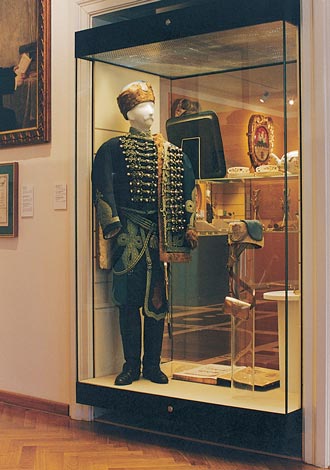Permanent Display 31. The Foundations of the Modern City
 The constitution imposed by Francis Joseph I created the foundation for the transformation and modernization of the Monarchy. This process included the remodelling of the Zagreb municipal government. After consultations with an organization commission (composed of the Gradec judge Janko Kamauff, Tomislav Cuculić and Augustin Dutković) had been held, the Imperial Patent of September 7, 1850 set up the Royal City of Zagreb (with 1,419 houses and 15,385 inhabitants) by uniting the free and royal city of Gradec, Kaptol, Nova Ves and Vlaška. The city was run by a commune council with the mayor at its head. The executive arm of the commune was called the magistrat. The commune council, through public competitions, selected and appointed officials, ran city affairs, drew up the budget, supervised the magistrat, promulgated laws, collected taxes, issued certificates of citizenship and ran military affairs. The citizens, on the basis of a census, elected the commune council, and took part in the work of the municipal government. Overall supervision of the work of the city authorities was vested in the Parliament and the Ban’s government. The city councillors (30 of them) were selected during one week, from May 12 to May 19, 1851. Janko Kamauff was elected mayor.
The constitution imposed by Francis Joseph I created the foundation for the transformation and modernization of the Monarchy. This process included the remodelling of the Zagreb municipal government. After consultations with an organization commission (composed of the Gradec judge Janko Kamauff, Tomislav Cuculić and Augustin Dutković) had been held, the Imperial Patent of September 7, 1850 set up the Royal City of Zagreb (with 1,419 houses and 15,385 inhabitants) by uniting the free and royal city of Gradec, Kaptol, Nova Ves and Vlaška. The city was run by a commune council with the mayor at its head. The executive arm of the commune was called the magistrat. The commune council, through public competitions, selected and appointed officials, ran city affairs, drew up the budget, supervised the magistrat, promulgated laws, collected taxes, issued certificates of citizenship and ran military affairs. The citizens, on the basis of a census, elected the commune council, and took part in the work of the municipal government. Overall supervision of the work of the city authorities was vested in the Parliament and the Ban’s government. The city councillors (30 of them) were selected during one week, from May 12 to May 19, 1851. Janko Kamauff was elected mayor.
The Imperial Patent, bringing the city government up to date, particularly with the separation of the administration and the legislature, laid the foundation for the creation of modern Zagreb.
The population of Zagreb was mainly Roman Catholic (in 1857 Catholics accounted for 92.29% of the inhabitants), and the new organization of the capital was accompanied by an ecclesiastical reorganization. In 1852, with the consent of the Court of Vienna, the Pope raised the church in Zagreb to the honours of an Archbishopric independent of the Archbishopric of Ostrogon, and Archbishop Juraj Haulik was appointed Cardinal (1853).
Ivan Ružić

